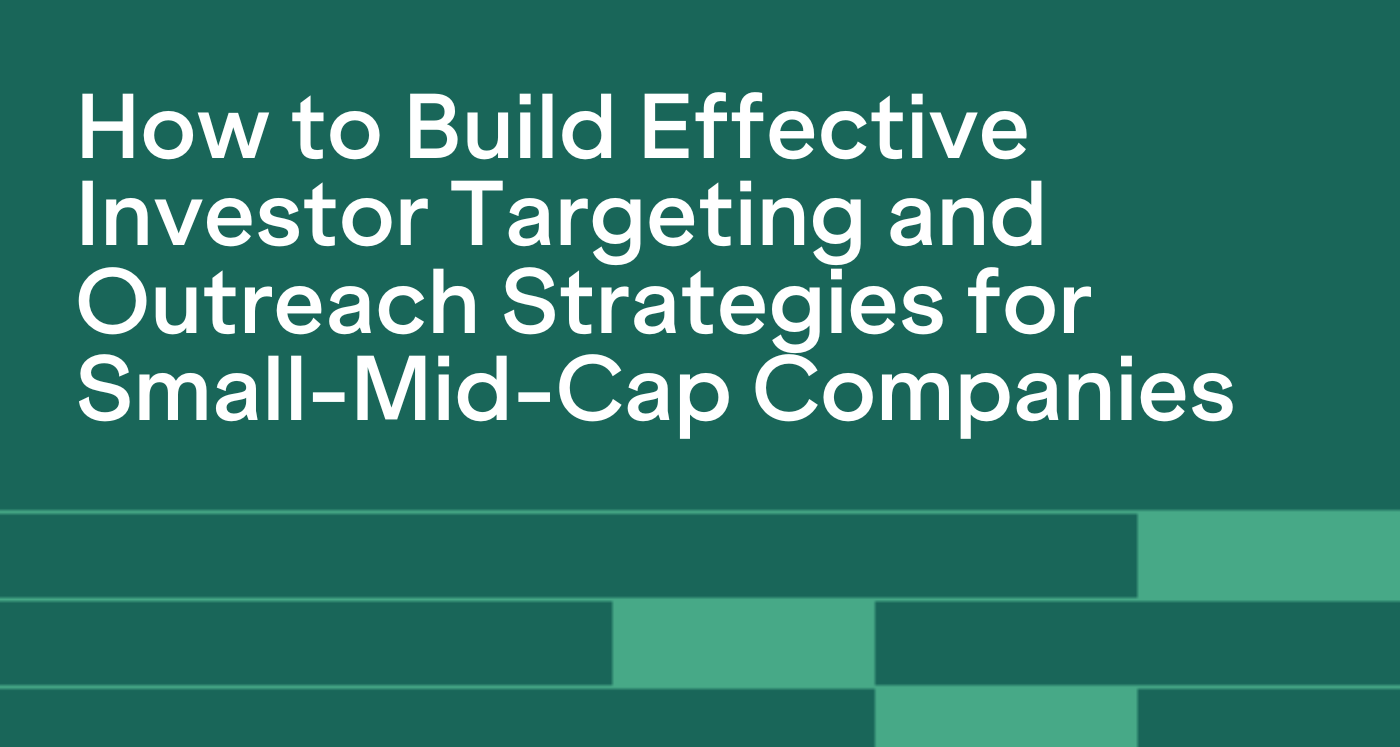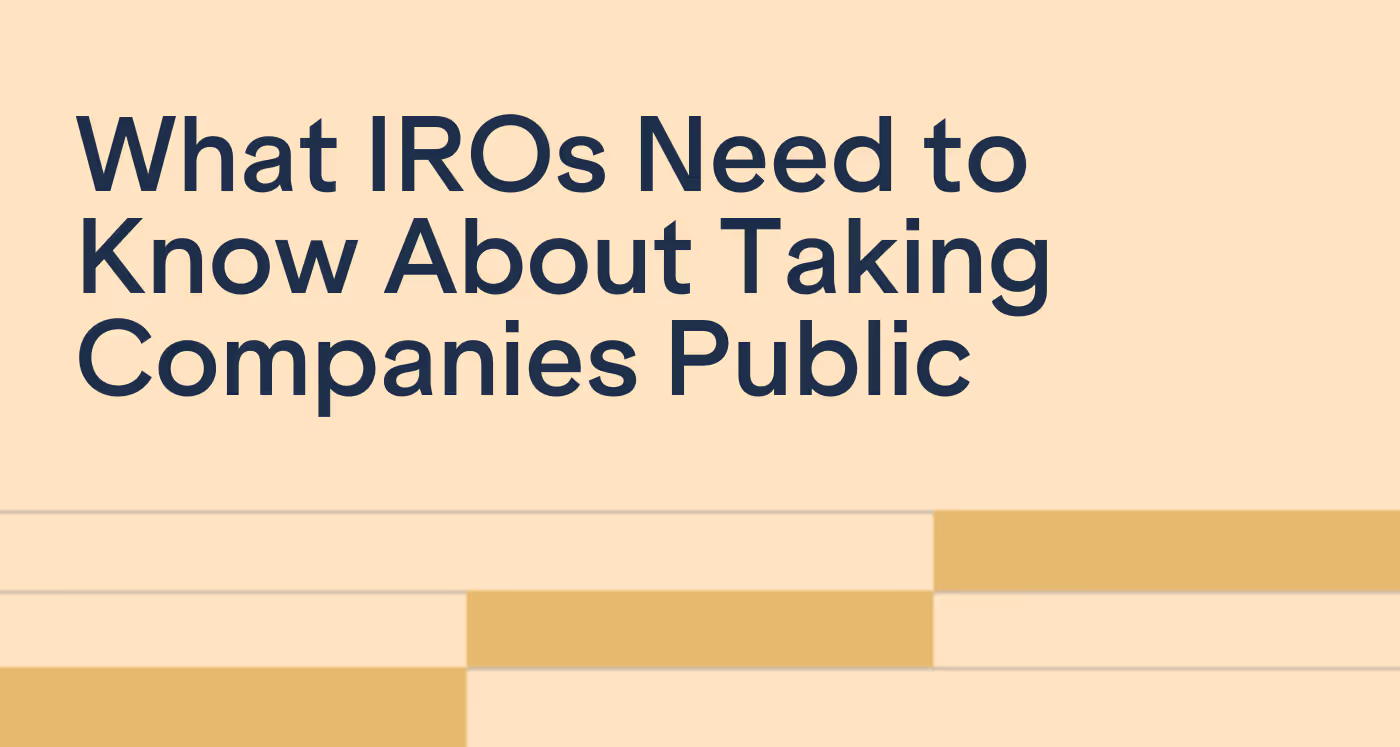
How to Build Effective Investor Targeting and Outreach Strategies for Small-Mid-Cap Companies
Learn how seasoned IR veterans are executing targeting strategies for small-mid-cap companies.

ESG is taking capital markets by storm, but many companies are unsure what it’s about or why it’s beneficial. We’ve broken down the essential components that you need to start an ESG strategy. This article will break down what ESG is, why it is important for investor relations, and how to get started with ESG.
Download Our Guide to the 6 Most Frequently Asked Questions About ESG
ESG stands for Environmental, Social, and Governance factors. While ESG indicators aren’t typically included in financial reports, there is rising interest from consumers and financial institutions in socially responsible investing. Companies that are aligned to positive ESG goals are less susceptible to the risks of a rapidly changing environment, and are considered more sustainable in the long term. According to the CFA Institute, these are some factors pertinent to ESG.
Environmental factors pertain to environmental stewardship, and the sustainable use of natural materials. Some environmental reporting factors include but are not limited to:
Social factors in ESG pertain to the human aspects of business, including the business’s relationships to customers, employees, and local communities. Social factors include but are not limited to:
The third aspect of ESG is governance. Largely, governance is used to assess how the company is run at the corporate level. Governance factors include but are not limited to:
There are many reasons why having an ESG strategy is beneficial to your organization. An increasing amount of money managers, including the largest in the world, have a strong ESG focus and will not invest in your company unless you meet certain ESG disclosure thresholds. Other benefits of proactive ESG disclosure include mitigating volatility, preventing corporate activism, and industry leadership opportunities.
The top money managers in the world are demanding better ESG disclosure. Among the biggest advocates for ESG is BlackRock CEO and Chairman Larry Fink, who discusses it annually in his letter to clients. But it’s not just BlackRock prioritizing ESG funds; all of the top institutional investors in the world offer arrays of ESG portfolios. As of 2020 ESG funds across the USA represented $17.1 Trillion AUM, or ⅓ of total American AUM.
Not only is ESG occupying a significant segment of the market, data from Morningstar Direct suggests the ESG market is growing year over year. It is clear that there is increasing demand from both institutional and retail investors for stock in companies that are aligned with ESG strategies. Naturally, inclusion in ESG portfolios is beneficial, as it grants you access to wider pools of capital.
.avif)
Beyond simply being popular on The Street, it turns out an ESG mandate can have a positive effect on stock performance. In 2020, ESG equity mutual funds and ETFs performed better than their closest conventional counterparts. This isn’t a new trend either. A study published by the Harvard Law School Forum on Corporate Governance tracked over 1000 US securities from 2013-2019 and found that there was a positive correlation between high ESG scores and profitability. By focusing on sustainability and ethical business practices, ESG companies were able to mitigate volatility. Whether this is due to keeping ahead of evolving business regulations or to appease the growing segment of ethically minded investors, it’s clear that ESG measures have the potential to positively impact your bottom line.
If your company doesn’t take the lead with your own ESG strategy, you run the risk that someone else will. Activist investors are known to target low performing companies, and lately activist hedge funds that specifically target ESG laggards are popping up. Even large and well known companies such as L Brands and Exxon have proven vulnerable to activist investors. The best way to deter ESG activist investors is to proactively craft an ESG plan and begin to follow ESG best practices.
If ESG is not a prevalent practice in your industry, you have the opportunity to become a leader in your industry by pioneering ESG best practices. While there’s already intrinsic moral value in socially responsible business practices, becoming an industry leader in ESG could also positively impact your bottom line and company value.
So what does it take to start an ESG strategy? We’ve broken down the initial legwork of an ESG strategy into 6 simple steps.
Before you commit time and resources for developing an ESG strategy, ensure that you have buy-in from your management team. Not only do you need to understand what resources your company has for this undertaking, you need to ensure that there is a willingness to allocate resources to other parts of your company to meet your ESG goals.
Even if you’re running a one person show you can still make progress towards improving your company’s ESG disclosure. While you may not be able to enact grand changes across the organization, you can still work with internal departments to conduct a baseline assessment of existing ESG policies and begin ESG disclosure.
It would be a mistake to classify ESG as a monolithic topic with objectively correct guidelines because what you need to disclose varies from industry to industry. There are an overwhelming amount of ESG issues, but not all of them will be relevant to your company. Material issues are the issues that are reasonably likely to impact the financial condition or operating performance of a company. Different ESG reporting frameworks may suggest varying material issues for your industry, so it’s beneficial to compare multiple frameworks to determine what is material.
We recommend taking a look at the SASB materiality map and the MSCI materiality map as a starting point for identifying material issues in your sector.
Whether or not you’ve actively reported on ESG in the past, your business has most likely been rated by one of the ESG scoring agencies. While there are numerous rating agencies out there, the two most widely used are MSCI and Sustainalytics. These agencies conduct their own ESG research using publicly available information, and issue reports annually. These annual reports are extremely helpful to understand specific risks in your current ESG strategy, and to benchmark your company against peers. You can access your own company’s report for free, however there may be an additional cost to access peer reports. As long as your company is publicly traded, you should take advantage of these scores to benchmark your current standing in the ESG landscape
Once you understand roughly what is material to your sector, you should align yourself with an ESG framework. Unlike ESG Scores which are determined for every publicly traded company, reporting against a framework is completely voluntary. Not only is using a reporting framework useful for shareholders and potential investors to understand your company’s ESG efforts, it also signifies that your company is taking an active approach to ESG.
There are several frameworks you can choose from to tell your ESG story. According to ESG Infinite, the framework set by the Sustainability Accounting Standards Board (SASB) is generally the preferred framework for issuers who are just starting out with ESG. SASB is a popular framework that is well known among investors. Additionally, SASB tends to be more flexible than some of the other frameworks, making it more approachable for issuers.
Other popular ESG disclosure frameworks include Task Force on Climate Related Financial Disclosure (TCFD), CDP (formerly known as Carbon Disclosure Project), and The Global Reporting Initiative (GRI). You may find that some ESG inclined investors have a preference for one framework or another. The framework you chose should reflect your company’s ESG story in the most accurate way possible and speak to both current and potential investors.
ESG Infinite offers a free primer on how to select the best ESG reporting framework for your company.
Once you have established your baseline ESG scoring and have begun to report against an ESG framework, you have the opportunity to start improving your ESG strategy. A good place to start is to compare your company to peers. You should investigate your peers’ ESG scores and their disclosures to help understand what other key players in the industry are doing to move the dial on ESG. You can bring these findings to management to demonstrate viable opportunities to improve upon your company’s ESG strategy.
Once you’ve finished your first ESG disclosure, you should make it accessible to investors. Publishing your ESG disclosures on your website is a good starting point, and you may also wish to update your current shareholders to let them know. Once your disclosure is published, you can also leverage it in your investor outreach to aid your discussions with socially conscious investors. Remember, ESG is an ongoing commitment and companies are expected to share updates on an annual or more frequent basis. If ESG is a strong suit for your company, consider incorporating it as part of your company story.
Ultimately ESG can be daunting, but it’s certainly not without its benefits. Whether you’re leading the effort alone or you have a blank check from management, tackling ESG disclosure can help lower your cost of capital. ESG can vary greatly from industry to industry, but the steps you take to get started are universal. Results won’t happen overnight, but persistence with ESG can help your company expand your shareholder base and excel in the long term.
Irwin's advanced targeting helps you find the right investors.

Learn how seasoned IR veterans are executing targeting strategies for small-mid-cap companies.

Elizabeth Librizzi breaks down the secrets of buy-side corporate access to help investor relations professionals utilize buy-side firms.

What IROs Need to Know About Taking Companies Public: Insights from award winning investor relations thought leader Catherine Buan.